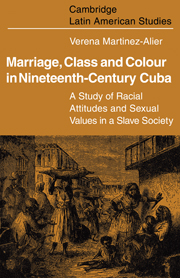 Marriage, Class and Colour in Nineteenth Century Cuba
Marriage, Class and Colour in Nineteenth Century Cuba Book contents
- Frontmatter
- Contents
- Preface
- List of abbreviations
- INTRODUCTION
- PART ONE INTERRACIAL MARRIAGE
- 1 Intermarriage and family honour
- 2 Intermarriage and politics
- 3 Intermarriage and Catholic doctrine
- 4 The white man's view
- 5 Colour as a symbol of social status
- 6 Intraracial marriage
- PART TWO HONOUR AND CLASS
- Appendix: Three Cuban genealogies
- Notes to the text
- Bibliography
- Index
5 - Colour as a symbol of social status
Published online by Cambridge University Press: 09 October 2009
- Frontmatter
- Contents
- Preface
- List of abbreviations
- INTRODUCTION
- PART ONE INTERRACIAL MARRIAGE
- 1 Intermarriage and family honour
- 2 Intermarriage and politics
- 3 Intermarriage and Catholic doctrine
- 4 The white man's view
- 5 Colour as a symbol of social status
- 6 Intraracial marriage
- PART TWO HONOUR AND CLASS
- Appendix: Three Cuban genealogies
- Notes to the text
- Bibliography
- Index
Summary
real colour and legal colour
Ideally, and according to the marriage legislation, nineteenth-century Cuban society was divided into two large groups, those of European origin and those of African origin, physical appearance serving as the criterion of distinction. Yet the implementation of phenotype as the principle of social classification had by then become rather complex. A high degree of racial mixture had taken place which had significantly blurred the visible boundaries between the racial groups. This process of growing diffuseness of the racial attributes was in large measure the consequence of the coloured woman's sexual exploitation by the white man and derived additional momentum from the powerful aspirations of the coloured population to shed their apparently racially determined inferior social status by shedding their typical physical attributes.
A royal decree of 1788 reveals a keen awareness of the problems involved in the overseas possessions in segregating its population along racial lines, and points to its causes:
the difficulty of implementing [the] Royal Pragmatic on marriage in view of the various castes of people … and the fatal mixture of Europeans with the natives and negroes … results from the fact that those proceeding from these mixtures in order to conceal their defect, attempt to register their baptisms in the books for Spaniards and erase from them by reprehensible means the information on their ancestry, later justifying with ease and the aid of witnesses that they are held to be white … which causes affliction to those vassals who are truly white and who cannot avoid marriages taking place between their families and those who being mixed pretend the contrary.
- Type
- Chapter
- Information
- Marriage, Class and Colour in Nineteenth Century CubaA Study of Racial Attitudes and Sexual Values in a Slave Society, pp. 71 - 81Publisher: Cambridge University PressPrint publication year: 1974


